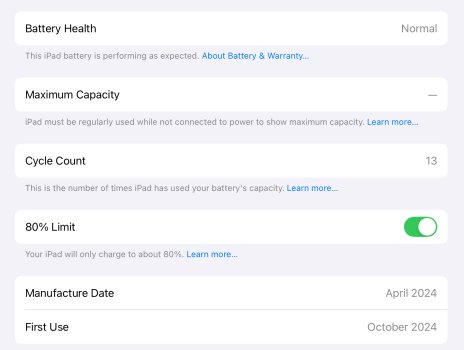Well I guess our views are not so distant then. I wouldn't say 64bits iPads were the issue, but 64bits OS versions. My 64bits mini 2 has great standby time on iOS 10, and despite a battery health of only 50% it's still very usable and will probably be for years to come (I only use it with 32bits apps, but every day for playing music).No, I agree: 32-bit iPads maintained practically (not completely, but almost) like-new battery life through all iOS updates, but like you said, they obliterated performance to the point of uselessness. Future iOS updates, up to a point, reverted it: performance is significantly better than it was back then, but they killed battery life (see early 64-bit iPads significantly or fully updated).
The interesting aspect about standby… is that it sucks on original iOS versions, too! This started on iOS 12 (or 11, not sure because I never used it on iPhones) and iPadOS 13 on iPads. My iPhone Xʀ on iOS 12? Poor standby battery life. My Air 5 on iPadOS 15? Poor, too! This is updates-agnostic, sadly. It was iPadOS on iPads, though, because my 9.7-inch iPad Pro on iOS 12 has great standby battery life.
Agreed in terms of performance with newer iPads. The issue today is battery life. And perhaps for some newer models it’s not an issue yet, but it will be in the future… which goes back to the thread itself: cycling an iPad so as to make it interesting is hard. You need to have an iOS version that doesn’t kill battery life (not necessarily the original, you can push a little), you need to be a heavy enough user so as to put in more than 1000 cycles, and you either need multiple iPads or you need to do it fast enough before compatibility is gone. Tough, especially with a good iOS version.
My highest monthly average on an original version iPad is 11 cycles/month, which is nowhere near enough. And that average plummeted afterwards. Because even if (and I agree for some models) battery life isn’t an issue now, it will likely be in the future (keep in mind that support has skyrocketed, iPads were supported through fewer major versions), which kills any interesting health-to-cycles-to-SOT number. Tracking a device that has been killed by iOS updates is not interesting to me. For me, they have no value. My 9.7-inch iPad Pro has no longevity value (or very little). Non-updated iPads lose usability (and therefore, relevance) once they get too old so as to use them on their original iOS version. What can you do with an Air 2 on iOS 8? Well… not much.
Only the heaviest users can make that number interesting in five years. I’m talking gaming at high brightness and things like that, throughout the whole lifecycle. Otherwise they end up with 700-800 cycles, and I know that’s not enough to cause any impact on original iOS versions.
With so many iPads I think that for you battery in general is irrelevant. Like you said, you don’t need SOT and standby battery life is already poor on original iOS versions (I can confirm that, like I said).
If you’re not using the iPadOS 15 iPad, then it’ll never get to that point. And in my humble opinion, it’s the most relevant iPad, as it will remain on its original iOS version, but it will never be used enough so as to get to a high number.
The real issue for "general use" iPads is loss of compatibility with apps. So far iPadOS 15 is still pretty good, but just go down to 14 and a lot of stuff does not work.
Will I keep my 16GB RAM M1 on 15 forever? I don't know, if I cannot do anything on it other than Windows, maybe not. But that's still in a distant future, for the next few years it will do fine.
I'll see what updates do to it's bigger M1 brother and decide if and when update it (and lose Windows). But probably not before another 5 years.


